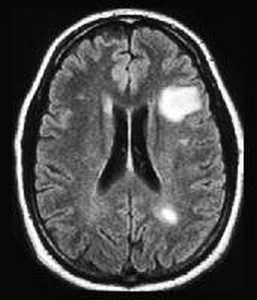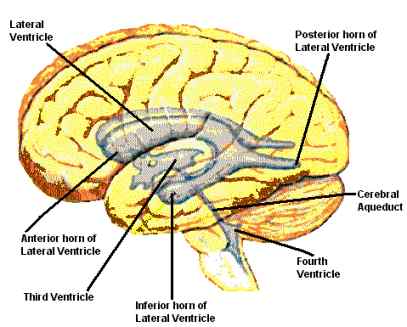

MedFriendly®


Multiple Sclerosis
Multiple sclerosis (MS) is a condition in which multiple
areas of abnormal patches (known as plaques) develop in
the brain and/or spinal cord (depending on the stage of
the illness). In MS, the destruction of a fatty substance
(known as myelin) is what leads to the formation of the
plaques. Myelin surrounds nerve fibers and helps them
send nerve impulses quickly. The formation of plaques
can cause nerve fibers in the brain and spine to harden,
a process known as sclerosis. The loss of myelin is why
MS is known as a demyelinating condition.
FEATURED: Overcoming MS: Evidence-Based Guide
WHAT CAUSES MULTIPLE SCLEROSIS?
MS lesions (white circles)
in the brain.
The exact cause of MS is unknown. However, MS is believed to be an autoimmune
disease. An autoimmune disorder is one in which a person's organs or tissues are
mistakenly attacked by his/her immune system (defense system). In the case of MS, the
body seems to attack myelin as if it is a foreign substance.
Because people who live in colder climates are five times more likely to develop MS than
people who live in warmer climates, the environment seems to play a role in the
development of this condition. In fact, spending the first 15 years of a life in a colder
climate seems to play a role in determining future risk of developing MS. More
specifically, a virus may be picked up during this time frame in early life, which then may
cause the disease to develop at a later period.
"Where Medical Information is Easy to Understand"™
Because relatives of a person with MS are more likely to develop
this condition, defective genes also seems to play a role in causing
MS. Genes are units of material contained in a person's cells that
contain coded instructions as for how certain bodily characteristics
(such as eye color) will develop. All of a person's genes come from
his/her parents.
WHERE ARE THE PLAQUES MOSTLY FOUND?
Plaques in multiple sclerosis mostly occur in the spine,

Periventricular white matter refers to white matter that is immediately to the side of the two lateral (side)
ventricles of the brain. White matter is a group of white nerve fibers that conduct nerve impulses
quickly. White matter is mostly made of myelin, the substance that gets destroyed in MS. White matter
is important for muscle movements.
Ventricles are openings in the brain that provide a pathway for cerebrospinal fluid. Cerebrospinal fluid is
the cushiony fluid that protects the brain and spine from trauma. The lateral ventricles are two curved
openings (shaped like a horseshoe) located deep within the top section of the brain.
The cerebral aqueduct is a narrow opening in the brain that connects the third ventricle with the fourth
ventricle, allowing cerebrospinal fluid to flow between these two areas. The cerebral aqueduct drains
cerebrospinal fluid from the third ventricle to the fourth ventricle.

The third ventricle is a narrow, four-sided, irregularly
shaped opening in the middle of the brain. The fourth
ventricle is a wide, flat open space located in the back
bottom part of the brain. The lateral ventricles, third
ventricle, fourth ventricle, and cerebral aqueduct are
pictured to the right:
In MS, plaques can also occur in the cerebrum (the top
section of the brain), cerebellum, and brainstem. The
cerebellum is an area in the lower back part of the brain
that is important for movement. The brainstem is an
area in the lower part of the brain that connects it with
the spinal cord. The brainstem plays a crucial role in
many functions that are crucial for life to continue.
WHAT ARE THE SIGNS AND SYMPTOMS OF MULTIPLE SCLEROSIS?
condition. The severity of the condition is largely determined by the size of the plaques and where they
are located in the brain or spine. The signs and symptoms are due to the destruction of myelin (see
above).
Abnormal sensations (called paresthesias) in the legs or hands, or on one side of the face, is often the
first sign of MS. Other early signs of MS include weakness, dizziness, loss of vision, double vision, and
nystagmus. Nystagmus is rhythmic involuntary jerking or swinging movements of the eyes.
Later signs of MS include bladder abnormalities, mood changes, abnormal reflexes, and ataxia
(uncoordinated walking) such as sensory ataxia. Other symptoms of MS include impaired eye
movements, impaired color vision, eye pain, loss of taste, increased muscle tone, loss of position
sense, loss of vibration sense, tingling, dysarthria (a type speech articulation difficulty), and feelings of
burning, warmth, and cold. If the neck is flexed, it can sometimes feel like an electric shock is shooting
down the spine to the feet.
About 90% of people with MS go through periods of increased symptom severity (known as relapses or
exacerbations) and decreases/absences of symptoms (remissions). However, 10% of people keep
getting worse without the symptoms going away for any period of time. Those whose symptoms get
worse without any remission of symptoms typically have more cognitive (thinking) problems than those
with the relapse-remitting form of the disease. The time period between exacerbations and remissions
decreases as the disease progresses. Since MS gets worse over time, it is called a progressive
disorder.
WHO IS LIKELY TO GET MULTPLE SCLEROSIS?
MS occurs mostly in young adults and typically begins slowly. Approximately 1 in 5000 people get this
condition and women are more likely to get it than men. People who live in colder climates are five
times more likely to develop MS than people who live in warmer climates. If a parent has multiple
sclerosis the child of that parent is 20 times more likely to develop MS. If a brother or sister has
multiple sclerosis, a sibling is 12 times more likely to develop MS.
HOW IS MULTIPLE SCLEROSIS DIAGNOSED?
There is no single definitive test to diagnose multiple sclerosis. Rather, the physician needs to take
multiple factors into account when making the diagnosis. One crucial factor is to exclude that the
patient's problems are not due to the many other disorders of tha brain and/or spine that can cause
similar signs and symptoms. Another factor is to consider the patient's age, since MS usually starts in
early adulthood.
When the physician suspects multiple sclerosis, he/she may perform a lumbar puncture (also known as
a spinal tap) to look for increased levels of protein in the cerebrospinal fluid. A lumbar puncture is a
procedure in which a needle is inserted into a space inside the spinal canal for the purpose of removing
some of the cerebrospinal fluid. The spinal canal is the space between the spinal cord and the bony
structure that surrounds it.
The doctor may also want to look at images on the patients brain and/or spine with a CT scan or MRI
(Magnetic Resonance Imaging). CT (computerized tomography) scanning is an advanced imaging
technique that uses x-rays and computer technology to produce more clear and detailed pictures than a
traditional x-ray. MRI scans produce extremely detailed pictures of the inside of the body by using very
powerful magnets and computer technology.
HOW IS MULTIPLE SCLEROSIS TREATED?
Unfortunately, there is no cure for MS. However, corticosteroids are often used to help control some of
the suddenly occurring signs and symptoms. Corticosteroids are a group of drugs that act similarly to a
natural chemical in the body known as corticosteroid hormone. Corticosteroid hormones control the
body's use of nutrients and the amount of water and salts in the urine. Other medications can be
prescribed to treat other specific signs and symptoms, such as medications to control depression and
medications to help better control urine output.
Physical therapy is sometimes used to treat MS because it can help strengthen muscles. A physical
therapist can provide a patient with various aids that can help him/her remain independent and move
around easier.
WHAT ELSE IS MULTIPLE SCLEROSIS CALLED?
MS is also known as focal sclerosis, insular sclerosis, and disseminated sclerosis.
HOW CAN I GET MORE INFORMATION ON MULTIPLE SCLEROSIS?
If you would like to learn more about multiple sclerosis, please go to MSactivesource.com and the
National Multiple Sclerosis Society, both of which are great websites that provides news, information,
and support for all people touched by this disease.
WHAT IS THE ORIGIN OF THE TERM, MULTIPLE SCLEROSIS?
Multiple sclerosis comes from the Latin word "multi" meaning "many," the Latin word "plus" meaning
"fold," and the Greek word "sklerosis" meaning "hardness." Put the terms together and you have "many
fold hardness." So multiple sclerosis refers to multiple hardenings in the brain and spine.














